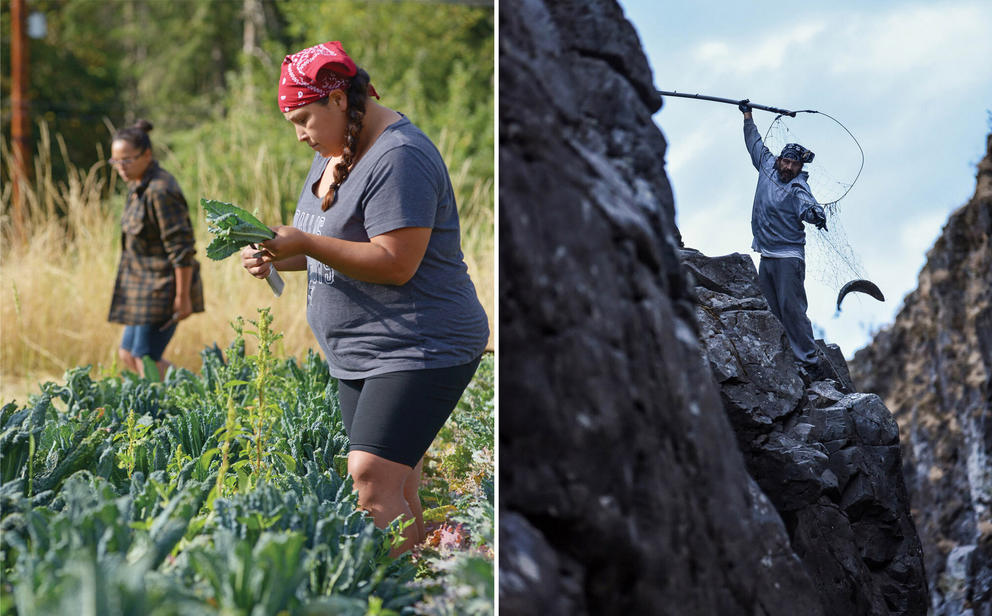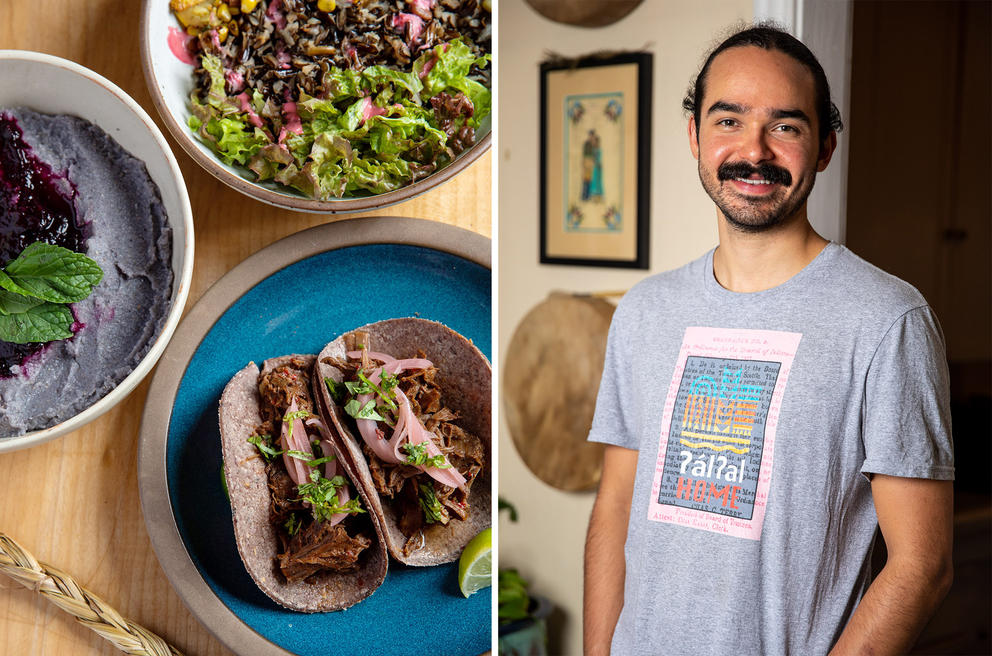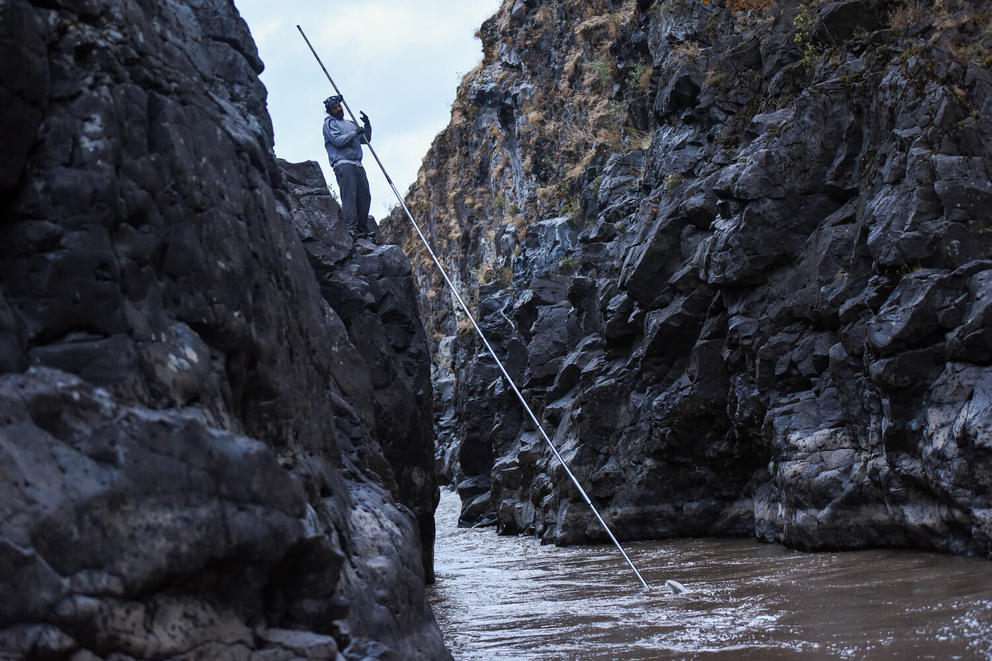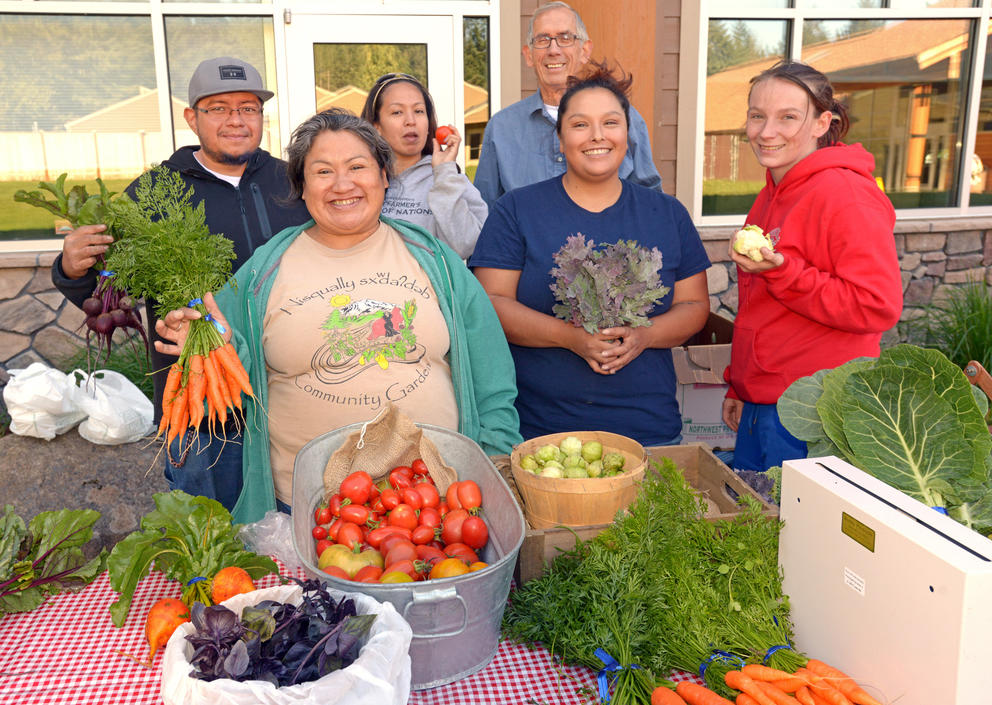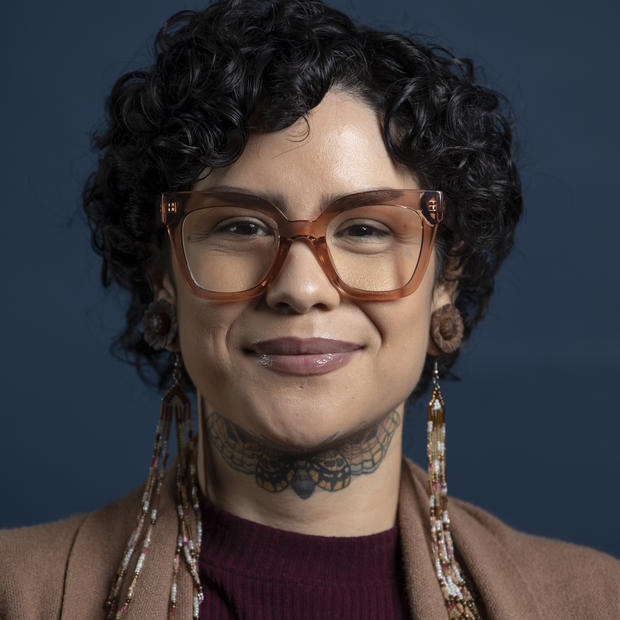Unfortunately, these treaty rights often were not honored, and many nations were forced from their traditional lands to unfamiliar territories, disrupting food systems and lifeways. As the commercial fishing industry grew, Coast Salish fishermen were seen as competitors, blamed for salmon decline and arrested for fishing from 1961 until their rights were restored by the 1974 Boldt decision.
The U.S. government weaponized Indigenous reliance and reverence for their traditional foods, and, through federal policies like the Religious Crimes Code of 1883, made Indigenous cultural practices illegal which resulted in violence and imprisonment if caught. The code wouldn’t be repealed until the 1978 American Indian Religious Freedoms Act.
Despite this history, Indigenous organizers and advocates are growing a food-sovereignty movement to reestablish access to first foods for Washington’s first peoples through community gardens, a new Seattle cafe and other projects including community education.
For Valerie Segrest, a Muckleshoot Indian Tribe member, Native foods educator, and nutritionist, food sovereignty can be defined as Indigenous people’s right to choose what they want to eat again.
“People have tried to sever our ties to [first foods] so our taste buds have literally been altered,” Segrest said.
“It was our ancestors’ priority to make sure that we ate those foods and we had access to them,” she said, “and that we could care for them and continue our very longstanding sacred relationship with these foods because they're not just foods, they're also our greatest teachers. They're what have taught us and still do teach us how to show up in the world and be good people.”
Spiritual well-being
Segrest said the salmon that are born in the Coast Salish ancestral rivers, travel to the sea and return home to the freshwater streams are a good example of these teachings. The fish, which are regarded as humankind’s equals, return, knowing that they're going to give their life so that the next generation can thrive.
“They're so generous, and we Coast Salish people see that as an act of love, generosity, abundance and adaptability,” Segrest said. “We ask ourselves how we too can live a life that's just as generous and just as adaptable and flexible as the salmon people have been. How we can live a life full of resilience and reciprocity.”
Segrest has coordinated the Muckleshoot Food Sovereignty Project for more than a decade. As the director of curriculum for the Muckleshoot Tribe from 2016 to 2019, she helped build lesson plans that supported traditional food teachings and education. The program is called The Cedar Box Teaching Toolkit, which includes lessons about the cultural traditions surrounding 13 native Salish foods.
The Muckleshoot Food Sovereignty Project emerged from efforts to increase access to the tribe’s traditional foods. The program offers edible education workshops in which tribal members are invited to share their traditional knowledge. Organizers also work with tribal cooks to develop healthy food guidelines that can be implemented from the daycare to the Senior Center. Some of these guidelines include eating a traditional meal like elk stew or roasted salmon once a week, prioritizing purchasing seafood from tribal fishermen and creating menus inspired by local first-foods availability.
For William Spoonhunter, a Yakama Nation tribal member, fishing runs in his family. His aunties and uncles endured being teargassed, beaten and imprisoned alongside Muckleshoot, Nisqually and citizens of several other tribal nations while protesting the Washington Department of Game for their fishing rights. Each nation has its own connection to salmon. For Spoonhunter, fishing is a spiritual experience.
In the Yakama creation story, the salmon offered themselves to the Yakama people and promised to come back if they agreed to honor the salmon every year. When the fish first return in the spring, Spoonhunter and other Yakama fishermen pause fishing for the ceremonial first harvest of the year, in which they honor the salmon, roots, berries and other traditional first foods.
Land stewardship
Archeological evidence shows that salmon have fed the Coast Salish for at least 10,000 years. Segrest sees this as a demonstration of Coast Salish sustainable fisheries and an illustration of the depth of knowledge of fish management that tribes carry. Unfortunately, salmon runs are now so low that Segrest fears she might be in the generation that sees the last salmon come up the river. Fourteen species of salmon and steelhead are listed as at risk of extinction under the Endangered Species Act, according to Washington’s 2021 State of Salmon in Watersheds report.
To obtain true food sovereignty, Segrest believes, there must be a return to traditional land management practices. During colonization, settlers perpetuated the narrative that the land was uninhabited, uncultivated and unmanaged, but nothing could be further from the truth, she said.
“We have certain harvesting practices that actually help invigorate growth and encourage growth in some of our wild plant species,” Segrest said. “We're pruning, we're coppicing, we're weeding, we're making an offering, we’re harvesting seeds and reseeding, we're fertilizing — all the things that you would do in a typical garden is how our lands here were managed pre-contact.”
The Coast Salish’s fishing and foraging traditions were not the only ways they practiced sustainable land management to cultivate first foods pre-colonization. Managing wildlife though hunting is equally important, said Anthony Johnson, Red Lake Ojibwe and manager of the soon-to-open ʔálʔal Café in Pioneer Square. Its name is pronounced all-all, and it sits on the ground floor of Chief Seattle Club’s ʔálʔal housing for previously unhoused residents, most of whom are Native.
The Washington Department of Fish and Wildlife canceled the spring bear-hunting season this year even though there is evidence of a healthy bear population. Johnson said the state’s decision was politically motivated because of the negative optics of hunting bears expressed by conservation groups who call it cruel.
“A Washington state agency made this decision based purely on political ideology, which is a colonizer mentality to limit people’s ability to go out and harvest food for their family and their communities,” Johnson said.
Economic opportunity
Johnson calls himself a “city Indian,'' a Native person who lives in the city instead of on a reservation. He grew up in Minneapolis, Minnesota and lives in Seattle now, so his barriers to food sovereignty are different from those of a Native person who grew up on a reservation. More than 70% of Indigenous people in the U.S. are urban Natives like Johnson, and many may have never accessed or been exposed to their traditional foods. It is through this lens that he works to create the menu for ʔálʔal Café, scheduled to open in November.
Among the members Chief Seattle Club serves, there is a spectrum of preference in traditional foods, according to Johnson. Some like the traditional, healthier option of blue corn mush served for breakfast, while others prefer biscuits and gravy.
Johnson believes in weaving traditional ingredients into familiar dishes to give them an Indigenous twist. For example, instead of making the sausage gravy with pork, the Day Center kitchen will use turkey, bison, elk or venison.
“I believe that our spirit knows and remembers what we're eating and leads to a bit of healing and a reclamation of our sense of self when we're eating those foods,” Johnson said. “But we're also not presenting foods in an inaccessible way where Chief Seattle Club members aren't going to want to eat it because it's too healthy or it doesn't look good. It's a balance between having traditional foods but not coming off as pretentious in the presentation of them.”
ʔálʔal Café won’t open officially until the end of November, but the Chief Seattle Club kitchen serves zero-cost meals to an estimated 80 members at Chief Seattle Club's Day Center next door. Johnson sources the café’s ingredients from Native vendors all across the country. In doing so, wealth is redistributed to Native peoples and advances various tribes’ endeavors to support their people with resources like food-sovereignty programs.
Johnson also feels it is important for his customers to understand where the café's ingredients come from: There’s blue corn from the Navajo Nation, bison from the Cheyenne River Sioux, wild rice from the Red Lake Nation. In doing so, Johnson hopes ʔálʔal Café can bring Indigenous customers a slice of home, regardless of what nation they come from.
“Seattle has such a diverse native community, and I think more than anything we need a gathering place for Natives that has representation from tribal nations across the country,” he said.
Yakama Nation fisherman William Spoonhunter dip-net fishes on the Klickitat River near Lyle, Washington. He hopes to pass on this tradition to younger tribal members. (Courtesy of Seattle Neighborhood Farmers Markets)
With the same ambitions in mind, Friends of Feed is working to identify all the Native food producers in Washington, Idaho and Oregon. Organizers plan to create a website that would connect people to Indigenous businesses and make it easy to support food-sovereignty efforts in tribal communities.
Friends of Feed comprises Seattle collaborators like the Urban Indian Health Institute, tribal education programs within Seattle Public Schools, and Chief Seattle Club, which has been part of food-sovereignty initiatives with Feed Seven Generations, a local iteration of the Muckleshoot Food Sovereignty Project.
Spoonhunter, the Yakama Nation fisherman, hopes to create opportunities for tribal members as well. He is the co-owner of seafood business Native Candy and hopes to recruit tribal members to teach them traditional dip-net fishing, which has been done for thousands of years at the Falls on the Klickitat River near Lyle, Washington. Traditionally a young person learns how to pack fish, then an elder shows them how to make a pole and, over time, how to dip-net fish. This technique requires Native fisherman to stand on cliffs above the white water, which can be dangerous.
Spoonhunter believes that a combination of traditional knowledge and what he has learned about the commercial fishing business is important for him to pass on to others. It is a difficult balance when you respect the salmon like Native fishermen do, Spoonhunter said.
“The hardest thing for me was to accept this paper money and give away this salmon,” he said.
Spoonhunter believes that how one cares for and handles the fish has an impact on its quality. He will never be caught throwing or slamming his fish. The fishing scene at Pike Place Market makes his aunt physically ill, he said. When clients tell him that his fish were the best they have ever tasted, he agrees with them, but he lets them know “I just take care of the fish. It's the fish.”
Food deserts
Access to these first foods is also imperative to the overall health and life expectancy of Indigenous peoples. Chantay Anderson, project coordinator for the Nisqually Community Garden, pointed to the issue of food deserts on reservations.
Before white settlers colonized what is now Washington, nearly 300 different kinds of foods were eaten in a Coast Salish diet, which is very different from the westernized diet many Native people now consume, which typically consists of just 13-20 different foods per year, according to Segrest.
Now, many reservations are considered food deserts: areas where there are not enough supermarkets to serve residents. With little fresh produce and other healthy food options available, people who live there become reliant on off-reservation supermarkets that can be hours away.
Native Americans make up less than 2% of the population but suffer from some of the highest rates of food insecurity, diet-related diseases and other socioeconomic challenges, according to a 2019 food security journal. It wasn't until the 1950s that the first case of diabetes was documented in the tribes of the Pacific Northwest. Now diabetes is among the top three causes of mortality in Indigenous people in the region, according to the Washington State Department of Health.
To combat this epidemic, the Nisqually Community Garden was born in 2009. The five-acre garden grows tomatoes, cucumbers, broccoli, kale, carrots and all the other common vegetables you find at a grocery store. The community garden is also home to an apple orchard, a large blueberry patch and Native plant medicines like nettle, fir tips, cedar and maple flowers.
When there is extra time and extra produce, garden workers make tinctures, salves, lip balm, lotions, elderberry syrups and other natural medicines. Everything that is harvested or created is distributed free to Nisqually citizens.
“Access is really important, and it feels really great to do the kind of work that can potentially make a difference in somebody's life,” Anderson, the project coordinator for the Nisqually Community Garden, said.
At the beginning of spring, new garden beds are built for elders who live on the reservation so that they can begin to grow their own food. From July through September, workers distribute boxes of produce grown at the garden to elders. The organization also sets up weekly garden stands that Nisqually tribal citizens can visit to pick up anything they might want or need.
Cultural identity
“The exact foods that we need to eat to increase our blood nutrient quality are always the first foods in this country,” Segrest said. She believes they have been overlooked very intentionally by the federal government to promote invisibility and erasure of cultures that took care of and cultivated those foods. “Part of our healing process is the visibility and helping people to value those foods as much as we do.”
“Native people and our foods are inseparable,” Johnson said. “You can't tell the story of Indigenous people without telling the story of our foods.”
Wild rice, for example, is at the core of the identity of Anishinaabe people, according to Johnson. There's a prophecy that the people needed to migrate until they found a place where food grows on water — and that's wild rice.
Indigenous food-sovereignty work prioritizes individual communities and is done through a cultural perspective. Segrest hopes that the Indigenous food-sovereignty movement inspires people from all backgrounds to start searching for answers in their own culture.
“There's so much value in our collective food history, so many teachings,” she said.
Correction: An earlier version of this story misidentified the year of the Boldt decision. The story has been corrected.

